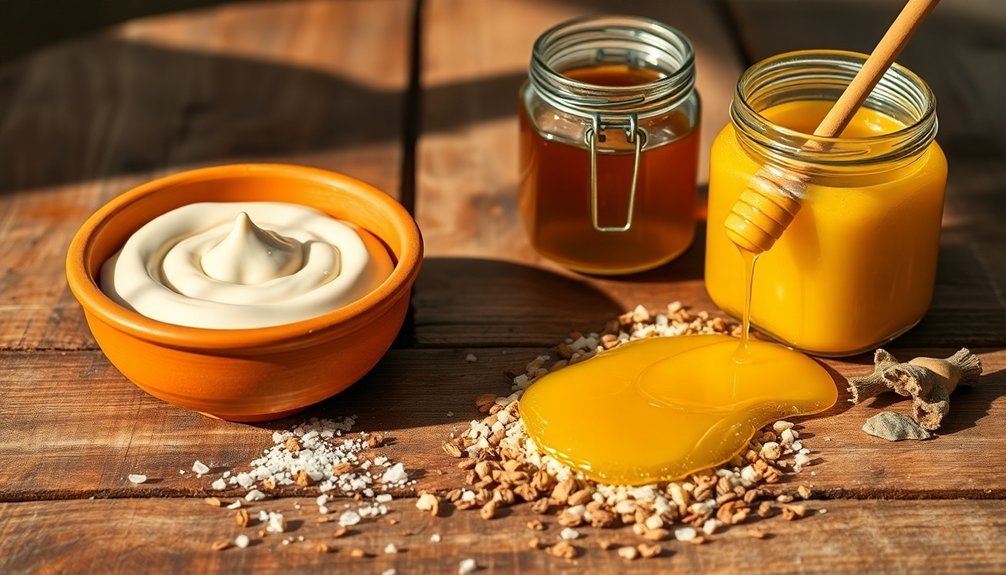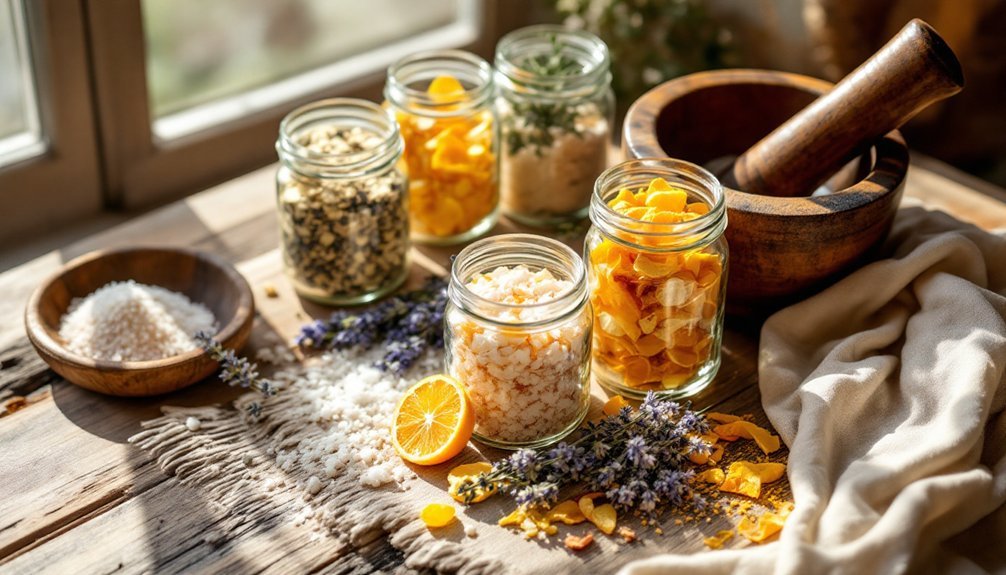Three cherished old-world family cleanser methods include Grandmother's Cold-Process Olive Oil Facial Cleanser, which uses olive oil to cleanse while preserving moisture; Traditional Herbal-Infused Milk Cleansers from Eastern Europe, incorporating regional herbs with nourishing oils; and Mediterranean Clay and Honey Washing Grains, combining antibacterial honey with mineral-rich clays for gentle exfoliation. These time-tested techniques avoid synthetic ingredients while maintaining your skin's natural balance. Discover how these ancestral formulations can transform your modern skincare routine.
Grandmother's Cold-Process Olive Oil Facial Cleanser

While modern skincare products crowd store shelves with synthetic ingredients, our grandmothers relied on something far simpler yet remarkably effective: olive oil. This ancient skincare secret works on the principle that "like dissolves like," allowing the oil to remove dirt and excess sebum without stripping your skin's natural moisture.
To use grandmother's method, warm extra virgin olive oil in your palms, then massage it onto your face. Steam your skin with a warm washcloth to open pores, and gently wipe away impurities. Unlike store-bought cleansers that often create a cycle of dryness followed by excess oil production, this method maintains your skin's natural balance.
Massage warm olive oil into skin with circular motions, then let a steamy cloth work its magic before gently wiping clean.
You can customize this cleanser by adding tea tree oil for acne-prone skin or sweet almond oil for extra moisture.
The polyphenols in olive oil provide anti-inflammatory benefits while improving skin elasticity and protecting against free radicals—a truly timeless skincare approach.
Traditional Herbal-Infused Milk Cleansers From Eastern Europe
Eastern European skincare traditions offer another timeless approach to natural cleansing through herbal-infused milk cleansers.
These formulations blend botanical wisdom with practical skincare, incorporating calendula, lavender, yarrow, and sage for their anti-inflammatory benefits.
You'll find that these cleansers typically combine herbal infusions with moisturizing bases like sweet almond or macadamia oil.
The recipes, passed down through generations, reflect the region's rich biodiversity and cultural heritage.
What makes these cleansers special is their connection to seasonal rituals and festivals, where specific herbs were harvested and prepared according to ancient knowledge.
Today's versions maintain traditional pH-balancing properties while embracing sustainable packaging and production methods. Modern formulations often include the Quadri Gold Complex® that combines multiple botanical actives for enhanced skin benefits.
They're living examples of how old-world wisdom continues to influence modern "clean beauty" approaches.
Mediterranean Clay and Honey Washing Grains

The sun-drenched shores of the Mediterranean have gifted us with one of skincare's most enduring treasures: clay and honey washing grains. This gentle yet effective cleanser combines raw honey's antibacterial properties with mineral-rich clays to purify skin without disrupting its natural balance.
To create your own washing grains, grind oatmeal and dried herbs into a fine powder, then mix with clay. Store this dry blend and only add honey when you're ready to use it. These natural ingredients will gently exfoliate the skin while maintaining its softness and smoothness.
| Skin Type | Recommended Clay | Optional Addition | Frequency |
|---|---|---|---|
| Sensitive | Rhassoul | Chamomile | Weekly |
| Oily | Bentonite | Tea Tree Oil | Twice weekly |
| Dry | Kaolin | Coconut Milk | Weekly |
| Combination | Red Clay | Lavender | Weekly |
Apply the paste in gentle circular motions, rinse with warm water, and follow with moisturizer.
Frequently Asked Questions
Can These Traditional Recipes Be Adapted for Extremely Sensitive, Rosacea-Prone Skin?
You can adapt traditional recipes for rosacea-prone skin by omitting baking soda, using gentle oils like jojoba, incorporating soothing ingredients like aloe vera, and always patch testing before full application.
How Do Seasonal Changes Affect Ingredient Availability for These Cleansers?
Seasonal changes greatly impact your ingredient availability. You'll find herbs abundant in spring, flowers in summer, mature crops in fall, and you'll need to rely on preserved ingredients during winter's limited fresh options.
What Are the Spiritual or Ritualistic Aspects of Traditional Cleansing Methods?
In traditional cleansing methods, you'll find spiritual elements like meditative preparation, intention setting with prayers, lunar timing considerations, and energy purification rituals. These practices connect you to ancestors while harmonizing your body, mind, and spirit.
How Did Families Preserve Cleansers Before Modern Refrigeration Existed?
Before modern refrigeration, you'd preserve cleansers by using natural preservatives like honey, drying herbs completely, adding salt or alcohol, storing in cool dark places, and making small batches to use quickly.
Can Men Use These Traditional Cleansers for Their Specific Skin Needs?
Yes, you can use traditional cleansers for your specific skin needs. They're adaptable for men's thicker skin, provide excellent exfoliation benefits, and can be customized for oiliness, sensitivity, or beard care requirements.
In Summary
You've now explored three time-honored cleansing traditions your ancestors relied on for generations. Whether you're stirring a cold-process olive soap, steeping herbs in fresh milk, or grinding fragrant clay with honey, you're not just making cleanser—you're preserving heritage. These methods connect you to your roots while nourishing your skin naturally. Try incorporating these simple rituals into your routine, and you'll keep family wisdom alive through your fingertips.





Leave a Reply